
You are reading the older HTML site
Positive Feedback
ISSUE
26
blue circle
FtTH integrated amplifier
as reviewed by John Acton
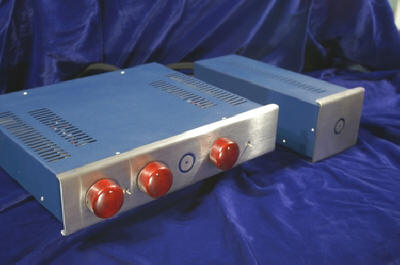
|
JOHN ACTON'S SYSTEM
LOUDSPEAKERS
ELECTRONICS
SOURCES
CABLES
ACCESSORIES
|
A funny thing seems to be happening in the world of integrated amplifiers. For years, audiophiles viewed integrated amps as a compromised component, a niche product for those valuing convenience and simplicity over performance. To be taken seriously by one's high-end audio peers, separates were the only way to go. Lately, however, a wave of no-compromise integrated amplifiers is hitting the market, a significant portion of which are being offered by traditionally separates-oriented high-end manufacturers such as MBL, Gamut, Conrad-Johnson, Burmeister, Krell, Edge, Jeff Rowland Design Group, Chapter Audio, etc. With the introduction of the FtTH, Blue Circle joins this illustrious group of high-end companies seeking to combine convenience, the traditional strength of the integrated amp, with ultimate performance, which has traditionally been the sole province of separate components.
The FtTH is Blue Circle's statement integrated amplifier, and as such, it incorporates much of the company's most significant technological advances. While technically an integrated amp, it is a two-box affair, with the power supply contained in a separate enclosure. Separating the power supply from the amplifier circuitry, specifically the delicate preamplifier circuits, addresses one of the key criticisms that proponents of separates have leveled at integrated amp designs: noise and interference between stages. The power supply employs separate toroidal transformers for the output stage, input stage and control circuitry in an effort to reduce these potential problems, and is connected to the main amplifier chassis via a three-foot DC power umbilical (different lengths are available upon request).
A hybrid design, the main FtTH chassis houses a 6922 tube-based preamplifier circuit and an op-amp-based power amplifier circuit. The power amp section utilizes the same proprietary True Balanced Output Technology output stage that is used in the flagship 200-series Blue Circle power amps, whereby the amplifier drives both the positive and negative loudspeaker terminals for greater control over the transducer diaphragms. Like all Blue Circle designs, the FtTH is hard-wired internally and makes use of top-notch components throughout. The well-regarded and expensive Shallco stepped attenuator is utilized for volume control, and in the FtTH, is employed in a dual-mono configuration one Shallco for each channel. Removing the cover allows the user adjustments―via internal toggle switches―to gain and Shallco attenuator sensitivity.
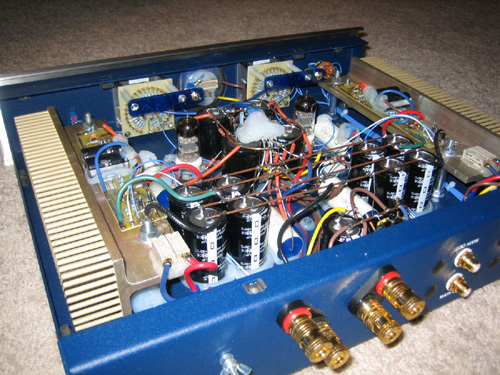
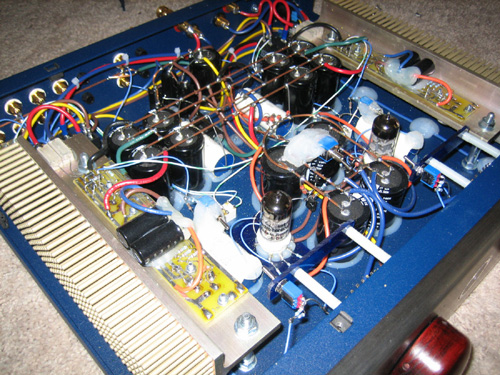
Like every Blue Circle product, the FtTH is designed first and foremost for performance, and as such, does not incorporate the bells-and-whistles found on other amps. The front panel of the FtTH contains two knobs for adjusting volume via the Shallco attenuators, as well as a third knob for selecting input source. Two toggle switches for power and tape monitoring complete the fascia. The rear of the FtTH contains high-quality RCA jacks for three sets of high-level source inputs, one set of preamp outputs and one tape monitor loop. Heavy-duty five-way speaker binding posts and an input for the power supply umbilical complete the back panel. As is the case with all Blue Circle offerings, the lettering on the back is provided in standard and mirror-imaged formats to assist those users making connections. The FtTH power supply unit contains no controls on the front and simply an IEC power inlet and DC power cord umbilical on the back. Both units possess the trademark Blue Circle circular logo on their faceplates, which light up blue when operating under power.
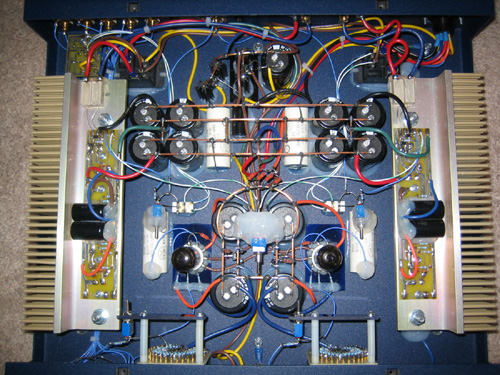
The FtTH is rated to deliver 95 watts per channel into 8 ohms and 125 watts per channel into 4 ohms. The FtTH is a high-current design, possessing more than 180,000uF of power supply capacitance and filtering. The FtTH employs a soft-start feature to prolong tube life. Like all Blue Circle products, the FtTH casework is available in a myriad of color and material options, albeit some at additional cost. Blue Circle will also work with customers to accommodate any reasonable feature/functionality customization desired (the most common being a home-theater processor pass-through). Remote control is not standard, but can be provided at additional cost. The FtTH amplifier measures 17.25" wide, 3.5" high and 14.25" deep (additional 2.25" clearance required for knobs on front and speaker binding posts on back). The FtTH power supply measures 5.75" wide, 5.25" high and 14.5" deep. The FtTH amp weighs 19lbs. The power supply weighs 22 lbs. Warranty for both pieces is three years.
As is his custom, Gilbert Yeung, chief Blue Circle designer, delivered the FtTH to me personally. The FtTH was well packed in two boxes (one box each for the amp and separate power supply). Upon unpacking, Yeung removed the cover of the FtTH amp, so that he could explain the location and purpose of the internal toggle switches for gain adjustment. As he walked me through his explanation, I could not help but notice how incredibly well constructed the FtTH is internally. Hand-made to the highest standards, the Blue Circle amp is truly a work of art.
Installing and configuring the FtTH amplifier proved to be straightforward, with the only consideration being to place the separate power supply within three feet of the main FtTH chassis. My rack only has accommodations for two components, so I placed the separate power supply on the carpeted concrete slab floor of my listening room—I did feel that the FtTH performed at its best with the power supply located as far away from the main chassis as possible. Even though my review sample was already broken in, I left the amp powered up constantly. Yeung approved of this approach, but stated that the stock Electro-Harmonix 6922 tubes were only good for 8 - 10 months under those conditions. The FtTH ran very cool and was essentially noiseless with my ears pressed right up to the tweeters in my speakers.
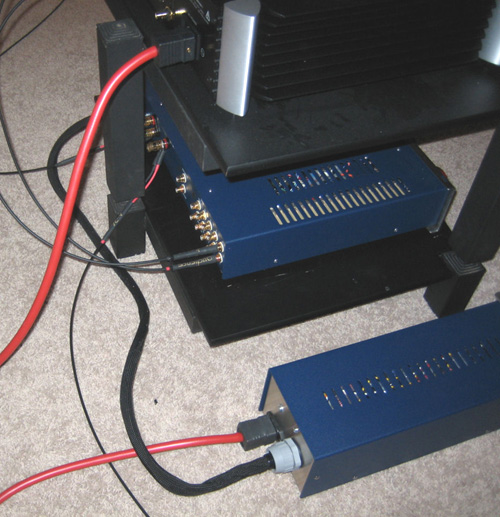
The FtTH proved to be an impressive performer, but perhaps owing to its high levels of refinement and resolution, the amp required a longer warm-up period than I am accustomed to. Initial listening impressions did not overwhelm me, and I was aware of a slightly bright treble coupled with a lack of involvement. As the FtTH warmed up and settled in, though, things improved remarkably―the brightness diminished, and the amp became much more involving and organic sounding. As I continued to listen critically, the primary sonic trait evinced by the FtTH was that of neutrality. Even more so than their NSCS integrated amp (that impressed me so much last year), Blue Circle's FtTH represented a completely transparent and uncolored window to the recorded performance. Surprisingly, the tube-based preamp did not add any overt sense of euphony or warmth to the presentation, but rather served to impart a greater sense of refinement to the performance of the amp. There was an organic human-ness and inner glow to the overall reproduction that was subtle, and yet, so instrumental in allowing me to listen through the artifice with which any stereo system, no matter how good, imbues on the underlying musical performance.
Listening to "King of the Mountain" and "Mrs. Bartolozzi" off of Kate Bush's latest recording, Aerial (Columbia 82796 97772 2), I was astonished to hear just how convincing Bush's vocals were, both tonally and spatially. The FtTH consummately walked that magical fine line between explicit rendering of detail and verisimilitude of timbre. Bush sounded alive and engaging as she sang, and although I could clearly discern every inflection of her voice, and even her intake of breath during quiet passages, my attention was never untowardly drawn to these things. The overall gestalt of her vocal performance was preserved, helping to manifest the illusion of life-like presence in my listening room. What was more remarkable was that I was able to hear all of this through the slight production glaze overlaying this recording.
This over-reaching ability on the part of the FtTH to transcend recording quality and transport me to the soul of the musical performance had me diving through my collection for other tarnished gems. First up was Fear of Music (Sire 6076-2) by the Talking Heads―a truly great musical performance marred by execrable recording quality, at least on the original CD version. No, the FtTH didn't transform the CD, but it did allow me to navigate through the sonic miasma that pervades the production on this recording and listen deeper into the mix. On songs like "I Zimbra", David Byrne's singing and Robert Fripp's guitar playing was more realistic sounding and easier to separate from the myriad of percussive noises. I was able to relax and enjoy the music more than I have via any other amp I've had in my system. And so it went, from Portishead and Traffic to early Fleetwood Mac and Jethro Tull. In every case, the FtTH never let me down, allowing me to better connect with the music buried under the avalanche of heavy-handed production methods and poor engineering / mastering techniques.
Turning to better-recorded fare, the FtTH's amazing transparency made the most of the California Guitar Trio's Yamanashi Blues CD (DR 9301 2). The sublime guitar playing on songs like "Melrose Avenue" and "Walk Don't Run" was portrayed with a beauty and depth I've heretofore been unable to realize in my system. The attack and decay of the guitar runs was palpably realistic, and the individual guitars were superbly rendered spatially. The ability to realistically place images within the soundstage was one of the FtTH's greatest assets, and this CD ably demonstrated how instrumental that attribute is to rendering a lifelike portrayal of the musical event. The FtTH represented the best amp I've heard in its ability to portray soundstage depth. Instrumentation was appropriately layered and, when the recording called for it, extended way back beyond the confines of the rear wall behind my speakers.
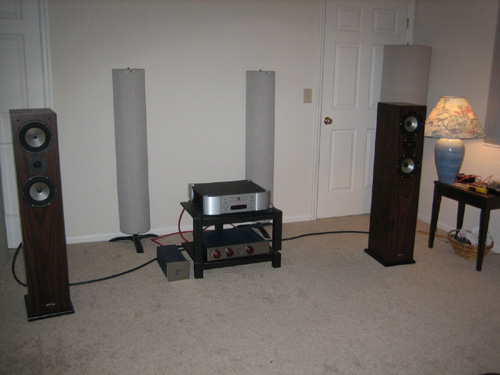
Like the NSCS, the FtTH excelled at its reproduction of treble instrumentation. Sibilants and cymbals were extraordinarily clean sounding, with no overhang or transistor hardness. There was plenty of air, and the remarkable resolution of the amp allowed the requisite bite of Miles Davis' trumpet on "So What" off of his seminal release Kind of Blue (Columbia/Legacy CK 64935), to be reproduced in all its glory, without any editorializing. The cymbal work was excellent, with the disparate ingredients of stick and metal present in condign proportions. In my experience, only the Almarro A318B SET tube integrated amp that I reviewed previously in PFO Issue 24 equaled the FtTH in its ability to faithfully render the treble registers.
The FtTH portrayed dynamic contrasts in a completely truthful manner, only bringing to bear its tremendous power supply reserves when the music called for it. The amp never drew attention to itself in sounding unduly big or small, but faithfully tracked the dynamic demands of whatever recording was being played. The FtTH had no issues whatsoever reproducing the high-level techno-strains of Underworld playing "Bruce Lee" off of their Beaucoup Fish release (V2 Records/BMG Distribution 63881-17042-2) one minute, followed the next by the intricate and subdued strains of Joni Mitchell singing "Woodstock" off of her Ladies of the Canyon CD (Reprise 6376-2).
What about the bass? Well, I've saved the bass for last, as I think it represents the only shortcoming I could find in the FtTH. While eminently controlled and extended, the FtTH didn't seem to possess quite the same level of sheer power and authority that I've heard in other amps. Keep in mind that this criticism is very slight, but I didn't get that shake-the-room impression of limitless power that I've heard from other designs, including Blue Circle's own NSCS. This was never an issue for me, and there was always a solid underpinning of bass foundation to every recording played. The FtTH didn't sound at all thin, it just didn't sound quite as muscular as some of its competitors.
The Audio Zone Amp-1 has been my reference for some time now, but the Blue Circle FtTH was superior in almost every aspect (perhaps not all that surprising given the disparity in price). The FtTH was the Amp-1's equal in transparency and immediacy, but went a step further in marrying that transparency with a very natural and human reproduction of timbre, especially in the all-important midrange. This is significant, as the FtTH represented the first amp I've heard in my system that equaled the Amp-1's remarkable immediacy and musical engagement. In comparison, the Amp-1 sounded a little threadbare and artificial, lacking the depth and organic flow of the larger FtTH. Couple the FtTH's preternatural transparency with its ineffable ability to humanize the musical event, and you have an amplifier that is truly world-class.
In many aspects, the Blue Circle FtTH is the finest integrated amplifier that I've had in my system. Possessing remarkable levels of poise, refinement and transparency, the FtTH does an exemplary job of reproducing the musical event. Without resorting to any engineered-in coloration, the FtTH delivers a transparent and resolving view into the recording, all the while connecting the listener to the underlying musical performance in a very organic and human manner. The FtTH may indeed be integrated, but it is in no way compromised. The flagship Blue Circle integrated is worth every penny of its asking price. John Acton
FtTH
Retail: $4695
Blue Circle
web address: www.bluecircle.com
